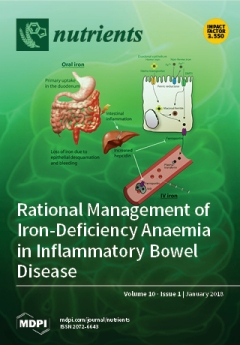1
Program in Human Nutrition, Department of International Health, Johns Hopkins Bloomberg School of Public Health, Baltimore, MD 21205, USA
2
Respiratory Epidemiology and Public Health Group, National Heart and Lung Institute, Imperial College London, London SW7 1BU, UK
3
Barts and the London School of Medicine, Queen Mary University of London, London E1 1BZ, UK
4
Department of Nutrition, Norwich Medical School, University of East Anglia, Norwich NR4 7TJ, UK
5
Upper Airway Research Laboratory, Ghent University, 9000 Ghent, Belgium
6
Research Unit of General Practice, Department of Public Health, University of Southern Denmark, 5000 Odense C; Denmark
7
Skin and Allergy Hospital, Helsinki University Hospital, 00029 HUS Helsinki, Finland
8
Deptartment of Pediatrics, Charité-Universitätsmedizin Berlin, 10117 Berlin, Germany
9
Institute of Social Medicine, Epidemiology and Health Economics, Charité-Universitätsmedizin, 10117 Berlin, Germany
10
Institute of Clinical Epidemiology and Biometry, Würzburg University, 97070 Würzburg, Germany
11
Department of Epidemiology, College of Medicine, Medical University of Silesia, 40-752 Katowice, Poland
12
Department of Immunology, Rheumatology and Allergy, Medical University of Lodz, 90-647 Lodz, Poland
13
Jagiellonian University School of Medicine, 31-008 Krakow, Poland
14
Clinical Department of Internal Diseases, Allergology and Clinical Immunology, Medical University of Silesia, 40-055 Katowice, Poland
15
Department of Immuno-Allergology, Coimbra University Hospital, 3000-075 Coimbra, Portugal
16
Division of ENT Diseases, Karolinska Institute, 171 77 Stockholm, Sweden
17
Division of Occupational and Environmental Medicine, Department of Public Health and Clinical Medicine, Umeå University, 901 87 Umeå, Sweden
18
Department of Medical Sciences, Respiratory, Allergy and Sleep Research, Uppsala University, 751 85 Uppsala, Sweden
19
Section of Occupational and Environmental Medicine, University of Gothenburg, 405 30 Gothenburg, Sweden
add
Show full affiliation list
remove
Hide full affiliation list
Abstract
Background: Flavonoids exert anti-inflammatory properties and modulate oxidative stress in vitro, suggesting a protective effect on lung function, but epidemiological studies examining this association are scarce. Methods: A stratified random sample was drawn from the GA
2LEN screening survey, in which 55,000
[...] Read more.
Background: Flavonoids exert anti-inflammatory properties and modulate oxidative stress in vitro, suggesting a protective effect on lung function, but epidemiological studies examining this association are scarce. Methods: A stratified random sample was drawn from the GA
2LEN screening survey, in which 55,000 adults aged 15 to 75 answered a questionnaire on respiratory symptoms. Post-bronchodilator spirometry was obtained from 2850 subjects. Forced vital capacity (FVC), the ratio between the forced exhaled volume in 1 second (FEV
1) and FVC (FEV
1/FVC), FVC below lower limit of normal (FVC < LLN), and FEV
1/FVC < LLN were calculated. Intake of the six main subclasses of flavonoids was estimated using the GA
2LEN Food Frequency Questionnaire. Adjusted associations between outcomes and each subclass of flavonoids were examined with multivariate regressions. Simes’ procedure was used to test for multiple comparisons. Results: A total of 2599 subjects had valid lung function and dietary data. A lower prevalence of FVC < LLN (airway restriction) was observed in those with higher total flavonoid (adjusted odds ratio (aOR), higher vs. lowest quintile intake 0.58; 95% Confidence Interval (CI) 0.36, 0.94), and pro-anthocyanidin intakes (aOR 0.47; 95% CI 0.27, 0.81). A higher FEV
1/FVC was associated with higher intakes of total flavonoids and pro-anthocyanidins (adjusted correlation coefficient (a β-coeff 0.33; 0.10, 0.57 and a β-coeff 0.44; 95% CI 0.19, 0.69, respectively). After Simes’ procedure, the statistical significance of each of these associations was attenuated but remained below 0.05, with the exception of total flavonoids and airway restriction. Conclusions: This population-based study in European adults provides cross-sectional evidence of a positive association of total flavonoid intake and pro-anthocyanidins and ventilatory function, and a negative association with spirometric restriction in European adults.
Full article






